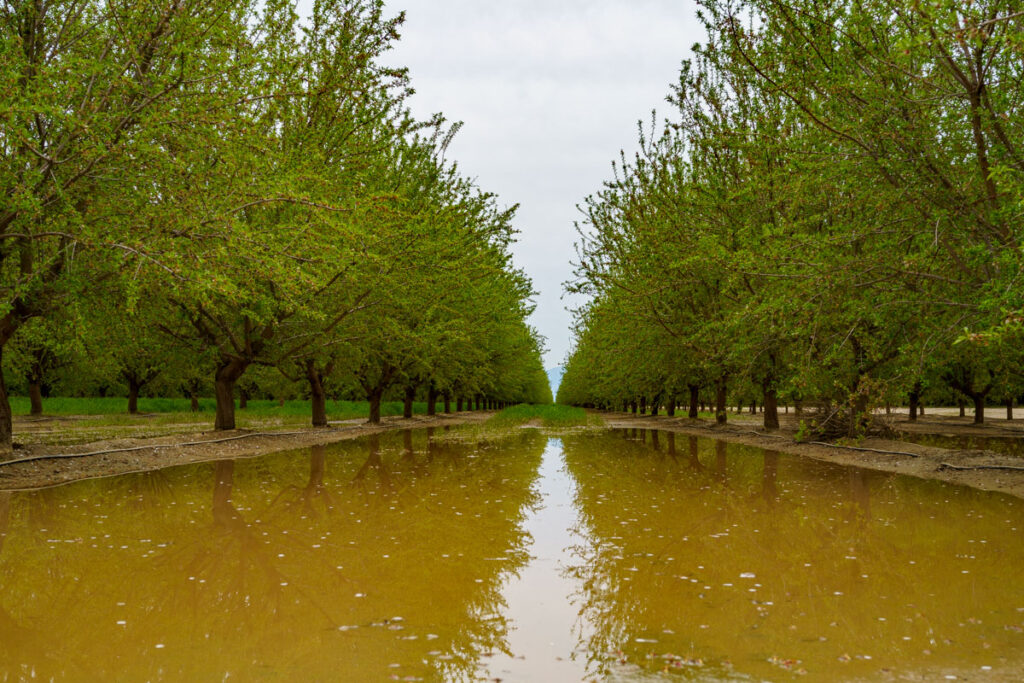If you are an almond grower, you may have noticed some of your trees suffering from lower limb dieback (LLDB), a condition that causes the death of branches in the lower part of the canopy. Almond lower limb dieback can reduce your yield and affect the quality of almond nuts, so it is important to understand what causes it and how to prevent it.
What is LLDB and how to spot it
Almond lower limb dieback (LLDB) is used to describe branch death that occurs in the lower half of the canopy. The limbs tend to start the year just like any other healthy limb on the tree. But at some point, usually after a hot spell, the leaves on the affected limbs begin to yellow, and eventually the whole branch collapses. If you peel off the bark of a dying limb, you may see brown spots or cankers in the wood, but without much gumming or girdling. The cankers are often associated with dead spurs or small branches on the top side of the affected limbs. The fungus that causes the cankers may spread up to the point of attachment with the main scaffold but does not seem to infect the large wood.
LLDB is more common on Padre and Butte varieties, but it can also affect other varieties such as Nonpareil, Fritz, Carmel, Wood Colony, and Mission. It can occur in orchards of any age, but it is more prevalent in orchards that are eight years old or older. It can also occur in orchards with any soil type, irrigation system, or plant spacing.
What causes almond lower limb dieback
The exact cause of lower limb dieback is still unknown, but it may be a physiological disorder related to water potential and light levels. Some factors that may predispose trees to LLDB are:
- Overly wet soils in spring that reduce root function and oxygen availability
- Low light conditions in the lower canopy that reduce photosynthesis and carbohydrate production
- Hull rot infections that weaken branches and produce toxins such as fumaric acid
- Root damage from herbicides, fertilizers, nematodes, or other factors that reduce water uptake and nutrient transport
- Secondary fungal infections from Botryosphaeria and Phomopsis species that colonize weak tissues and cause cankers
How to prevent almond lower limb dieback
To prevent LLDB, you should try to keep your trees healthy and strong by following these almond orchard management practices:
- Avoid over-irrigating in spring and monitor soil moisture levels regularly
- Prune your trees to improve light penetration and air circulation in the lower canopy
- Control hull rot by applying fungicides at hull split or reducing nitrogen fertilization
- Avoid root damage by applying herbicides and fertilizers according to label directions and soil tests
- Monitor your trees for signs of LLDB and remove infected limbs promptly to prevent fungal spread
Almond lower limb dieback is a severe problem that can affect your almond production and profitability. By understanding its symptoms and causes, you can take steps to prevent it and protect your orchard.
How AgNote will help you with your almond orchard management
Almon orchard management can be challenging. You must keep track of your irrigations, fertilization, pest control, harvest and more. That’s why you need AgNote, the farm management software that will make your life easier and your orchard more productive. It is a cloud-based platform that lets you monitor and control your orchard from anywhere, using your smartphone, tablet, or computer.
AgNote will help you optimize your inputs, reduce your costs, increase your profits, and improve your sustainability. AgNote is the ultimate tool for almond growers who want to take their orchard management to the next level. Try it today and see the difference!
